|
Sherburn - Blackpool
Friday, 19th March
I got up at 6.00 am, re-checked the NOTAMS
to see if anything new had appeared or changed since the day before
and printed off the F214, F215 forecasts, TAFs and METARs
before heading over to Sherburn.
At the Aero Club I finished my plan and briefed Steve & Geoff
regarding the route I would be taking to Sligo. Geoff declared
he'd probably take a nap across the Irish Sea as his house
alarm had gone off at 4.30. Fortunately it had been a false alarm.
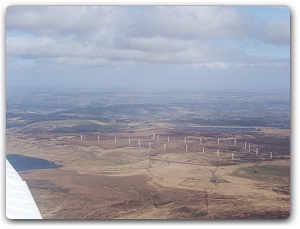
Then I noticed a text from Brian Cattle. He'd been enjoying himself
flying a Bulldog all week and was also planning a
trip to Ireland, Cork in fact, the same day.
"'See' you in Ireland? Our plan is filed
for a 10.30 departure".
After finishing breakfast we headed out to load up the plane.
The runway in use was 24 and at 10.25 we took off into a very bumpy wind.
Geoff pondered whether to call up Fenton and decided, given we
were taking the Whiskey departure, to change frequency straight
to Leeds Bradford.
After exiting the MATZ Steve advised he would climb to and stay
at 2,000 feet until we crossed the Leeds zone.
Geoff contacted Leeds Approach: "PA28 out of Sherburn, currently
over the A1 and routing to POL. Request Basic Service". Leeds
asked us to squawk 2677 and advised we were clear to enter
the zone not above 2,000 feet.
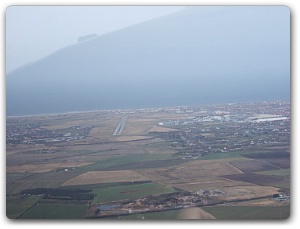
Having passed over Leeds we were coming up to Bradford and I
noticed Mannigham Mills in the distance with its distinctive
Italian style chimney.
Shortly afterwards we were overflying
Foster's mill in Queensbury and then Ovenden
Moor towards the POL VOR.
At POL Geoff changed frequency to Warton and I noticed a pilot
negotiating a route through the Manchester low level corridor.
There was a short delay following our initial call. The ATC
finally advised the QNH was 1009 and asked us to squawk 3641
for conspicuity.
Unusually for me I was beginning to feel a tad queasy as a
result of the bumpy air despite having had a good breakfast.
I figured it was probably the result of all the additional
movement with taking pictures en route and trying to type notes
into my tiny netbook so made myself sit relatively still
for the rest of the leg.
Steve advised he would route into Blackpool to the north of
the M55 and the danger area. "We should see the airfield on
the nose", he declared. "I'm expecting 25 or 28".
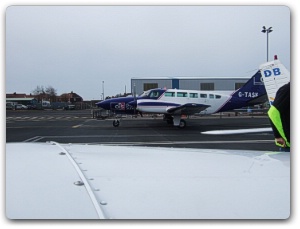
On reporting the airfield was in sight, Geoff was asked to
change frequency directly to Blackpool Tower on 118.4. The
frequency was busy and we were unsure they'd heard our message.
"Golf Delta Bravo, six minutes to run, request join and landing
information". "Runway 28, report right base, QFE 1008" was the
immediate response.
As we approached the runway the tower controller
instructed us to report final; we were number two to land with a
helicopter on right base. The wind was 250° at 12 knots".
As it was fairly breezy with a crosswind, Steve decided not
to deploy the drag flap and after landing we were advised to
vacate at Delta 2 and hold at Delta 1. Then we were
instructed to follow the Cessna landing on 25 which
exited at Alpha 1. This enabled us to park up at the
fuel pumps for re-fuelling.
Blackpool - Sligo
At Blackpool we refuelled, checked the weather and filed our flight plan
to Sligo. Unfortunately the cafe was closed, so we had to go without
lunch.
Then I noticed another text from Brian - he hadn't managed to get to
Ireland as visibility at Cork had been only 500 metres. I replied
to let him know we were going ahead with our flight to Sligo.
I made sure I had the plates to hand for the alternate airfields: Isle
of Man, Dublin, Newtownards, Belfast, Enniskillen and Connaught. The
NOTAMs indicated that the Enniskillen NDB was u\s and to be aware of
migrating flocks of geese at Sligo; also turbulence if the wind was
south westerly.
I checked the ATIS for Blackpool and the runway in use
was 28, wind was 240° at 9 knots. There were few clouds at
3,500 feet and visibility was 22km; QNH 1009, temp +9° C,
dew point +6° C.
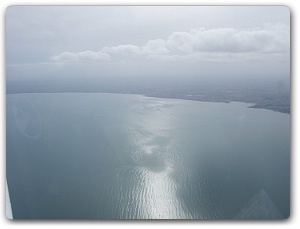
Afterwards I contacted the tower and requested taxi instructions.
I was advised Information Uniform was now
current and the runway in use was 25. Familiar with the taxi
ways I could find my way easily to Bravo 4.
However on coming up to the hold I was planning to turn to the
right in order to park into wind when the ATC advised me to line
up on 25 and undertake the power checks.
Just this tiny bit of information overloaded me - had he really
just said that? I slowed down almost to a halt.
Steve nodded and read back the instructions for me.
I back-tracked, lined up on 25 and undertook the power checks.
After acknowledging completion the ATC advised I was cleared
for take-off with a right hand climb out.
On taking off I suddenly realised the DI was not properly aligned
with the compass. I couldn't have checked it properly
on the ground. To get onto my westerly heading and out of Blackpool's
ATZ I had to fly on the compass.
Once straight and level, Steve started looking at the DI. It became
apparent that the slave was no longer working correctly. It would have to be
re-aligned regularly along the route.
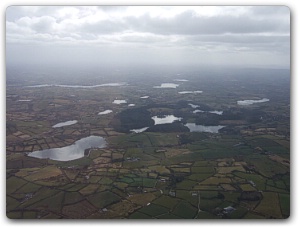
On the ground I'd set NAV1 to pick up the IOM VOR and would cut the
185-from radial at an estimated 18nm when abeam the end of the island.
Although still VMC I found the flying very challenging focused
on a slither of blue grey horizon and everywhere around me
featureless.
After 50 minutes we reached the tip of the IOM the ADF pointed back towards
the airfield and the 185 radial came in. We were slightly less than 18 nm
from the VOR. I then undertook a FREDA check and changed fuel tanks.
My next waypoint was the DUB 360-from radial which we would cut coasting
in at Dundalk 28nm north of the VOR.
The second part of the crossing was
uneventful and it was heartening to set eyes on land once more.
As I coasted in at 14.58 I did another FREDA check and changed tanks again.
Steve was now talking to Dublin who asked us to Ident.
The landscape in front of us was unlike any I had seen before. It was
beautifully green and punctuated by a myriad of lakes (or loughs) of different sizes.
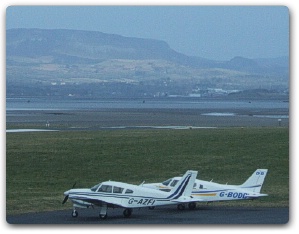
The headwind was proving to be as strong as forecast and the cloud base
was between 3,000-4,000 feet so after Cavan we decided to route directly,
north-west across the mountains, to Sligo. Shortly we were abeam Lough
Allen and discovered Foxtrot India was not far behind us.
On nearing the airfield Steve changed frequency to Sligo and said farewell
to Shannon. We could join on final for 29. A little later I realised the
wind had changed as I needed to crab in a north easterly direction to
stay lined up. I asked Steve to get a wind check. Sure enough there was
now a northerly crosswind of about 9 knots.
The descent down to the runway was quite spectacular with the PAPIs
and pulsating green lights across the sands. Nearly three hours after
leaving Blackpool we arrived on terra firma once more. We parked up
and waited for Foxtrot India which landed only minutes later.
In the airport we went up to the tower to close our flight plans and
say hello to the controller, Trish, who Steve had now met several times
before.
Then we took taxis from the airport (15 Euros) to the Sligo City Hotel
where we checked in for two nights (133 Euros each). After a refreshing glass
of the most wonderful Guinness I had ever tasted we went to get ready for dinner.
Sligo - Inishmore
Saturday, 20th March
We were not holding out much hope for good weather as a warm
front was forecast to sweep across the UK from the south.
But when I got up around 7.30 am to start writing up my notes
I noticed the weather was not at all bad.
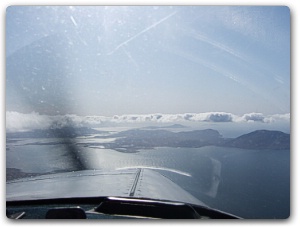
At 9.30 Geoff phoned me.
Where was I (engrossed in writing) and did I fancy a trip down to Galway?
I showered, got ready and had my breakfast in record time. At around
10.30 we planned our route around the coast down to the Aran Isles
and left for Sligo airport.
At 11.40 we took off from 29 and were asked
to report reaching the 10 mile boundary. I set the NDB and
the TDME 109.0 frequencies so that I had a rough idea of our distance.
Then the Sligo controller asked if we'd filed a flight plan. "Negative",
I responded.
"That's okay
I'll file one for you", was the friendly response. I advised our route
would be around the coast down to Inishmore to land and that we would
be remaining outside of Connaught's airspace.
At the boundary I said farewell to Sligo and changed frequency
to Shannon Information. "Golf Delta Bravo, pass your message".
"Golf Delta Bravo, PA 28 out of Sligo, routing Inishmore via the coast,
VFR at 2, 500 feet, request Basic Service".
1 - See note below.
The controller advised the QNH was 1006, that there was no known
traffic to affect us and to report at Belmullet. "QNH 1006, report
Belmullet" I then hastily looked at the map. Belmullet turned out
to be an airfield on the mainland just north of the Aran Isles.
The scenery was spectacular in the sunshine and we noticed the pristine
deep blue sea was free of any shipping. Steve reminded us to look out
for Clifden. Nearby was the landing site of the first trans-Atlantic flight
made by Alcock & Brown in 1919.
When I reported we had Belmullet in sight I was asked to change frequency
to Inishmore on 123.0 and to close our flight plan once on the ground. We
would now be transmitting blind on the Aran Group's frequency.
As we flew towards the second island we pondered which runway to use.
It was most likely going to be the north westerly one, but we decided to
overfly it and check the windsock. As luck would have it, as we approached,
I noticed Foxtrot India announce they were lining up for departure.
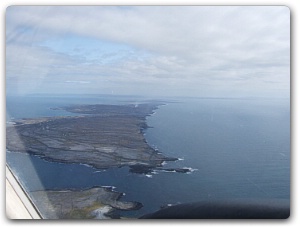
"Foxtrot India, this is Delta Bravo. Which runway are you using?" "Three two" was the reply.
Geoff decided to join overhead and we clocked Foxtrot India taking off well below us.
"Watch out for the bump in the runway", warned Foxtrot India.
The runway was only 520 metres in length and Geoff executed a fine landing
handling the extra challenge of a kink in the runway with finesse. On the ground
I asked Foxtrot India to relay closure of our flight plan.
Note
-
The Basic Service is recognised in the UK only so I
should have requested a Flight Information Service.
Inishmore - Galway
After a 15 minute break we decided to get back in the air with Steve
as pilot in command for the flight to Galway. We did a circle of the three islands
to take a look at the other two runways. Inishmore was definitely
in the best shape.
I got out the plate for Galway and initially contacted Shannon Information.
A now familiar voice asked me to pass my message. After reaching the Galway
boundary Shannon asked me to contact Galway Tower on 122.5. I said my
farewells and contacted Galway.
"Galway Tower, Golf Bravo Oscar Delta Bravo, request Basic Service".
"Golf Delta Bravo, pass your message". "Golf Delta Bravo, PA28 out
of Inishmore, VFR 2,000ft, routing Galway to land, request Basic Service".
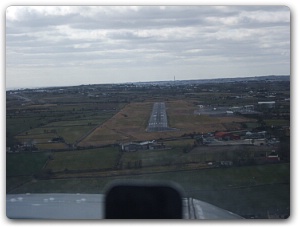
"Golf Delta Bravo, Galway QNH 1007, cleared to enter the zone, report
boundary". I read back the message and set the NDB and
TDME frequencies.
On reaching Galway Bay I checked the DME which indicated we were 11.6 miles
away and advised Galway we were approaching their boundary. The ATC
advised us to join 26 left-hand and call on final.
After landing we decided to re-fuel and see if we could get some lunch.
Unfortunately we were to go hungry a second day as the cafe was closed.
In fact the only activity at the airport appeared to be the Saturday
afternoon fire crew training and they were hoping to finish in time
for the rugby (Ireland vs. Scotland).
Galway - Sligo
I'd opted to fly the last leg back to Sligo and, after doing the
power checks, was cleared to backtrack 26 and line up. Finally I
was cleared to take off. I left the Galway circuit on the downwind
leg before climbing to 2,000 feet.
We reported at the 10 mile boundary and then changed frequency to
Shannon Information. On the ground Geoff and I had decided to
track to the Oscar Kilo NDB (rather than the CON VOR) as this
would be on a direct track back to Sligo.
Shannon was unable to give us clearance through Connaught's
airspace so we changed frequency to Connaught who cleared
us through their zone.
On approach to the NDB we clocked the Connaught runway in all
her glory - runway lights, PAPIs and pulsating omnidirectional
lead-in centreline strobes. (Unfortunately we failed to get a picture of it).
We changed frequency to Sligo just outside the boundary
and were advised to join on left base for 29. As I approached
the mountain to the south west of the runway a plane was taking off
and asking about traffic (us).The controller responded and I quickly
added we were now joining left base.
The runway looked glorious in the sunshine and on final I was
cleared to land on 29. After landing and vacating the runway
at hold Alpha, I noticed
the huge Sikorsky Search & Rescue helicopter on the apron and
I was asked to park up behind our sister aircraft, Foxtrot India.
The controller explained the Sikorsky was on call so he
wanted both planes as far away as possible from the helicopter.
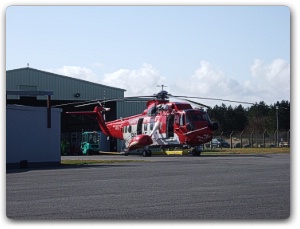
Geoff and I stayed out on the apron to see if a member of the Sikorsky
crew was about. We might just get a chance to peek inside the helicopter.
Luckily one of the crew, Dermot, was showing some enthusiasts around it.
Search and Rescue (SAR) in Ireland, and at the Sligo Airport base, is provided by
a civilian operator CHC, Canadian Helicopter Corporation,
on behalf of the Irish Coastguard. Dermot explained
that there were four crew including two pilots and they worked 24 hour shifts.
Though the helicopter was a 1950s design, it had been refurbished
in the 1970s and most parts replaced plus an extra section had been
added at the front end.
Afterwards we went over the cafe (open 07.30-18.00 and 10.00-18.00 weekends)
for some badly needed sustenance. Here we watched the Aerarann evening flight
arrive from Dublin and marvelled at its ability to turn 180 degrees on almost
a postage stamp.
Later we left for our hotel to get ready for another evening out with
the Foxtrot India crew. At the restaurant we happily recounted our
adventures of the day.
Sligo - Blackpool
Sunday, 21st March
On getting up I checked the mountains to the north east of Sligo.
The cloud base was quite low covering the tops but by the time we
reached the airport the weather had improved.
Over a cup of tea we started our flight planning and got talking
to one of the flying club instructors. He advised that later in
the day he was going up with an American woman (a member of the
Ninety-Nines) who had just started working in Ireland.
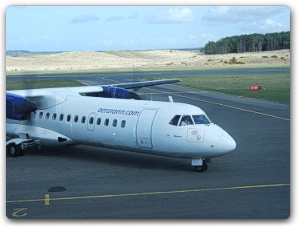
To be on the safe side we opted to do the reverse of my intended
route from Blackpool to Sligo. This would take us down to Lough
Arrow, across to Cavan and Dundalk on the coast avoiding the
mountains altogether.
To complete our flight planning we asked if we could go up to
the tower and get the TAFS and METARS etc. Here we got chatting
to the controller who was on duty over the weekend and had filed
our flight plan the day before.
He advised us that the morning Dublin flight was due in at 11.05 and
due out again at 11.30 so he would have to give it priority for
re-fuelling. Meanwhile we filed our flight plan and checked the
TAFS and METARS.
Dublin, Liverpool & Manchester reported either CAVOK or NOSIG.
The TAFs indicated the weather was likely to deteriorate later
in the afternoon & into the evening, but we would be home by then.
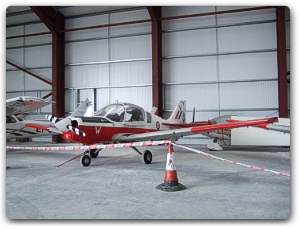
We thanked the controller and then went downstairs
to go through the security checks before being allowed
out onto the apron. Whilst waiting to refuel,
Geoff and I peeked inside one of
the hangers to find a Bulldog and Chipmunk parked together.
2 - See feedback on article below.
We had pondered which runway to use as the wind was pretty much adjacent
to it either way and the Aerarann had in fact taken off from 11. However
by the time we were ready to line up, the wind favoured the 29 runway.
Once airborne and out of the circuit Geoff handed over the radio to me.
At the boundary I said my farewells and thanks to Sligo and changed
frequency to Shannon Information. The Shannon QNH was 1012, we were
asked to squawk 0216 and report abeam Cavan (our halfway point to the coast).
We were then asked our ETA to Cavan. "Standby", I responded. After a
brief discussion we decided it was 13.40 and I passed the information
to Shannon.
At Cavan we said goodbye to Shannon and hello to Dublin Information.
The controller advised the Dublin QNH was 1013 and to remain clear of
controlled airspace.
At the coast, just south of Dundalk, the air had become a little bit
turbulent so Geoff asked me to request a climb to 4,500 feet which was
agreed. At about 20 miles from the Irish coast Dublin advised us to contact
London Information or Ronaldsway. We opted for the latter.
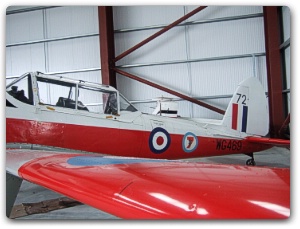
Ronaldsway advised the QNH was 1014, asked us to squawk 4552 and a Basic
Service was agreed.
After passing the Isle of Man I checked the ATIS for
Blackpool on COM2. Information Kilo at 13.54 advised: runway in use 28, QNH 1015,
FEW 4,000, SCT 4,800, temp 11°, dew point 5°, and visibility 40km.
I set the Blackpool NDB and TDME frequencies. We were about 38 miles from the
coast now and Geoff asked me to request a descent to 2,500 feet.
Once the airfield was in sight, I said farewell to Ronaldsway and hello to
Blackpool. The Blackpool frequency was incredibly busy but I managed to
call them and request a Basic Service.
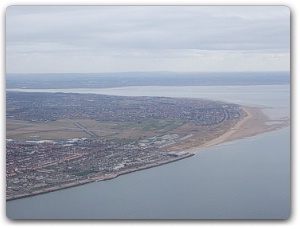
They responded with a squawk code which I read back and then attempted
to dial into the transponder. Unfortunately at the one most crucial point
of the journey where we really needed it, it had failed.
I tried re-cycling it several times and then Steve pointed out that we'd
not been asked to pass our message and therefore had not advised we were
inbound to land.
As soon as the next conversation ended I jumped in.
"Golf Delta Bravo, negative squawk; inbound Blackpool to
land; airfield in sight".
The ATC immediately asked us to join
downwind for 28. Once we reached the downwind leg he then asked us to
orbit left when abeam the right base leg. He had another plane inbound
on final approach.
After the orbit he asked us to proceed to right base and advised we were
number two to land after the King Air. As Geoff turned I managed to clock
the traffic at one o'clock and informed the ATC we were visual with it.
Feedback on article
-
Brian Cattle: The Bulldog you have there is a T1 variant the same
as the one I flew and is XX631/W, which served with the Northumbrian
University Air Squadron. The Chipmunk is WG469 and belonged to the
7th Air Experience Flight, the forerunner of the Air Cadets.
Blackpool - Sherburn
After a good break at Blackpool, I phoned Sherburn to find out what
the weather was doing on the other side of the Pennines.
Julia on the Flight Desk advised the weather was just fine and the sun
had been shining all day.
Prior to starting up the engine I checked the ATIS: Information
Mike advised runway in use 28; surface wind 190°/07; visibility 40km+;
SCT 3,800 ft.
We were instructed to go to hold Bravo 4 for a departure from 25. After the
power checks the Tower requested we expedite to line up on 25 which we
duly did. "Right hand turn-out, cleared for take-off".
Within moments we were up in the air. We departed the circuit from the
downwind leg and I requested an initial climb to 2,000 feet which was
approved. We were then asked to change frequency to Blackpool Approach
who advised us the QNH was 1015; asked us to squawk 0455 and report crossing
the M6. Fortunately the transponder was working again.
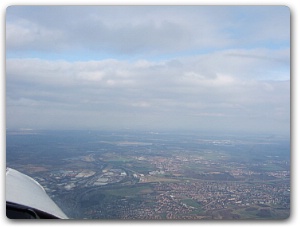
I requested a further climb to 3,000 feet for Steve which was approved.
Soon afterwards we were advised to contact Leeds Approach.
Leeds Approach was extremely busy, but I managed to get my call in
advising we were out of Blackpool routing to POL and 20 miles to the
west of it at 3,000 feet. The Leeds QNH was 1015; we were asked to
squawk 2677 and advised we were clear to enter their zone.
I noticed the ATC was being quite vigilant regarding frequency changes.
She was asking each pilot to notify her when they were going to change
frequency.
Eventually we crossed the zone and could already see the white sheds
(industrial park behind the airfield) of Sherburn. I advised the ATC
we had the airfield in site and requested a radio frequency change
to Sherburn. We were nearly home after a wonderful weekend's flying.
|

 Home
Home Sligo - Dundalk
Sligo - Dundalk Dundalk - Blackpool
Dundalk - Blackpool Blackpool - Sherburn
Blackpool - Sherburn Sligo Airport
Sligo Airport